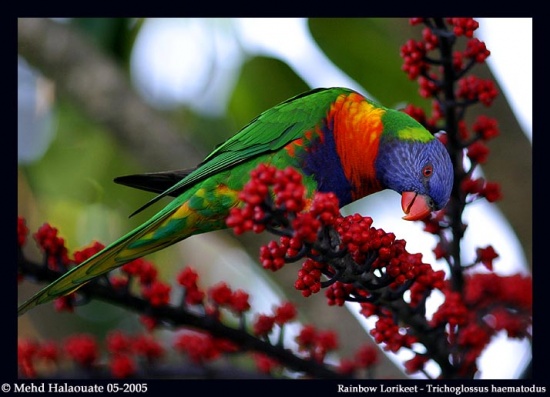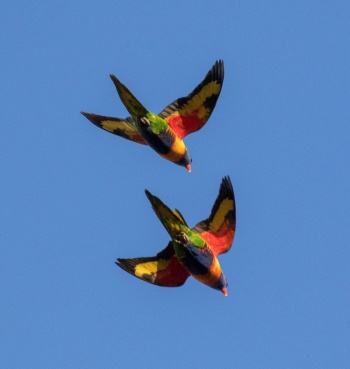- Trichoglossus moluccanus
Identification
The Rainbow Lorikeet is up to about 14 inches (35 cm) long. They weigh about 5 ounces (133 grams).
These parrots have brightly-colored red, green, blue, yellow, and orange feathers; the curved bill is red.
The males and females are hard to distinguish.
Distribution
Found in eastern and south-eastern Australia.
Taxonomy
Several species have been split from these taxon recently: Red-collared Lorikeet, Leaf Lorikeet, Marigold Lorikeet, Sunset Lorikeet, and Coconut Lorikeet. Gill and Donsker also split rosenbergii from Biak as Biak Lorikeet. However not all authorities have adopted these splits.
Subspecies
Two subspecies are recognized[1]:
- T. m. septentrionalis: Northeastern Australia (Cape York Peninsula); also islands in the Torres Strait
- T. m. moluccanus: Eastern Australia, from northeastern Queensland (south of the Endeavour-Daintree Rivers) south to Victoria, and west to southeastern South Australia, including the Eyre Peninsula and Kangaroo Island. Introduced in Western Australia (Perth
Habitat
The prefered habitat is coastal forests as well as urban gardens.
Behaviour
Noisy flocks of up to several hundred may congregate in flowering trees to feed and roost, at times in the company of Scaly-breasted Lorikeets.
Breeding
Breeding in the wild is from August to January. There are 2 to 3 white eggs in each clutch (a set of eggs laid in one nesting period). The eggs are laid in a tree cavity high above the ground. The female incubates the eggs for 25-26 days, and the male feeds her. Both parents will feed the chicks.
References
- Clements, J. F., T. S. Schulenberg, M. J. Iliff, S. M. Billerman, T. A. Fredericks, B. L. Sullivan, and C. L. Wood. 2019. The eBird/Clements Checklist of Birds of the World: v2019. Downloaded from http://www.birds.cornell.edu/clementschecklist/download/
- Braun, M.P. et al. (2017). Influences of oceanic islands and the Pleistocene on the biogeography and evolution of two groups of Australasian parrots (Aves: Psittaciformes: Eclectus roratus, Trichoglossus haematodus complex). Rapid evolution and implications for taxonomy and conservation". European Journal of Ecology. 3 (2): 47ñ66. doi:10.1515/eje-2017-0014.
- del Hoyo, J., Collar, N. & Kirwan, G.M. (2019). Rainbow Lorikeet (Trichoglossus moluccanus). In: del Hoyo, J., Elliott, A., Sargatal, J., Christie, D.A. & de Juana, E. (eds.). Handbook of the Birds of the World Alive. Lynx Edicions, Barcelona. (retrieved from https://www.hbw.com/node/467530 on 1 December 2019).
- Dutson, G. (2011) Birds of Melanesia, Christopher Helm, London.
- Gregory, P. (2017) Birds of New Guinea, Including Bismarck Archipelago and Boughainville. Lynx Edicions, Barcelona.
- Juniper, T. & Parr, M. (1998) Parrots: A Guide to Parrots of the World. Yale Univ. Press, New Haven and London.
- Schodde, R. & Mason, I.J. (1997) Aves (Columbidae to Coraciidae). In: Houston, W.W.K. & Wells, A. eds. (1997). Zoological Catalogue of Australia. Vol. 37(2). CSIRO Publishing, Melbourne.
Recommended Citation
- BirdForum Opus contributors. (2024) Rainbow Lorikeet. In: BirdForum, the forum for wild birds and birding. Retrieved 16 May 2024 from https://www.birdforum.net/opus/Rainbow_Lorikeet
External Links
Use Trichoglossus+haematodus to find





